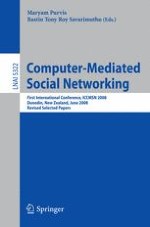2009 | Buch
Computer-Mediated Social Networking
First International Conference, ICCMSN 2008, Dunedin, New Zealand, June 11-13, 2008, Revised Selected Papers
herausgegeben von: Maryam Purvis, Bastin Tony Roy Savarimuthu
Verlag: Springer Berlin Heidelberg
Buchreihe : Lecture Notes in Computer Science
